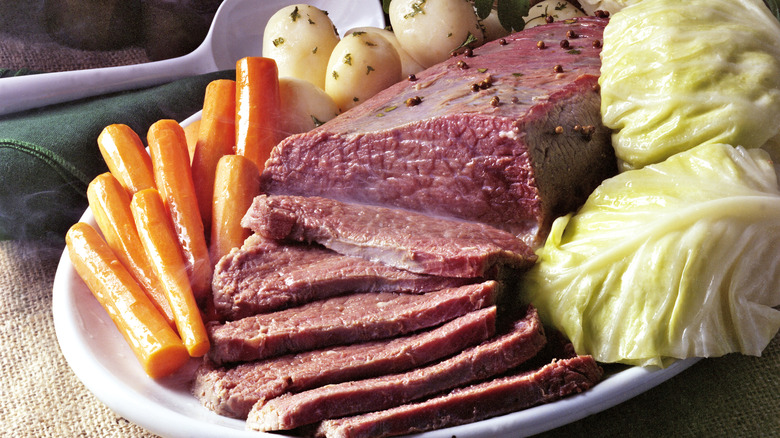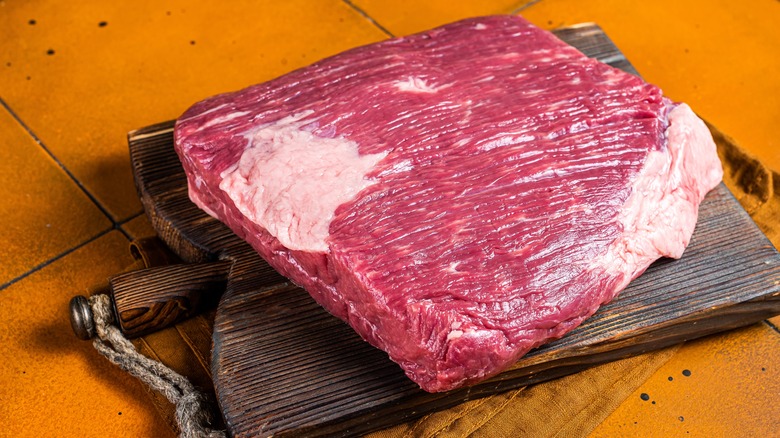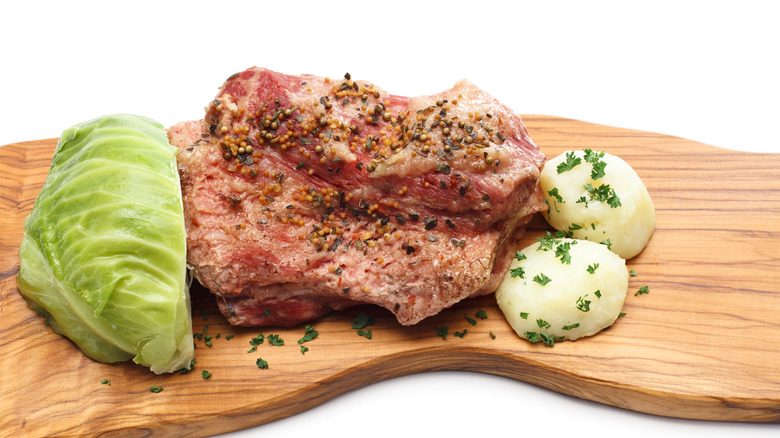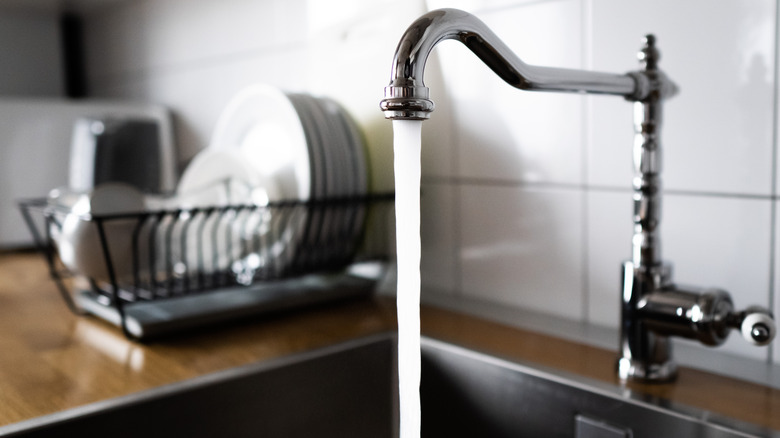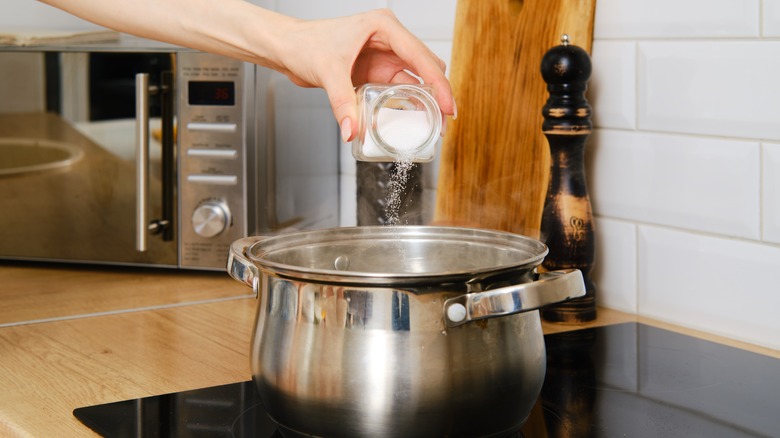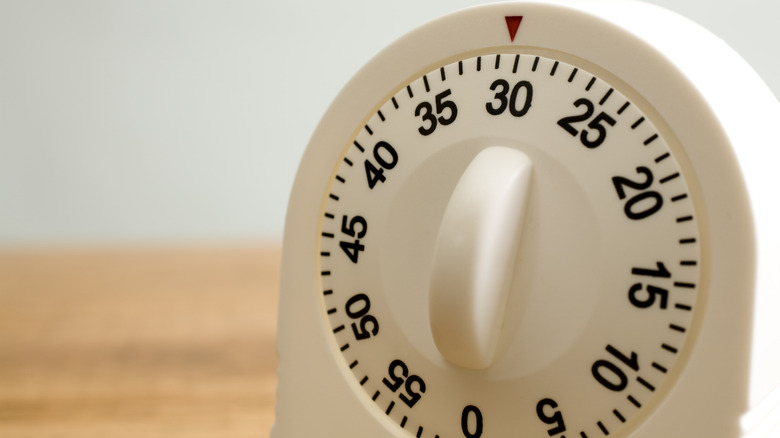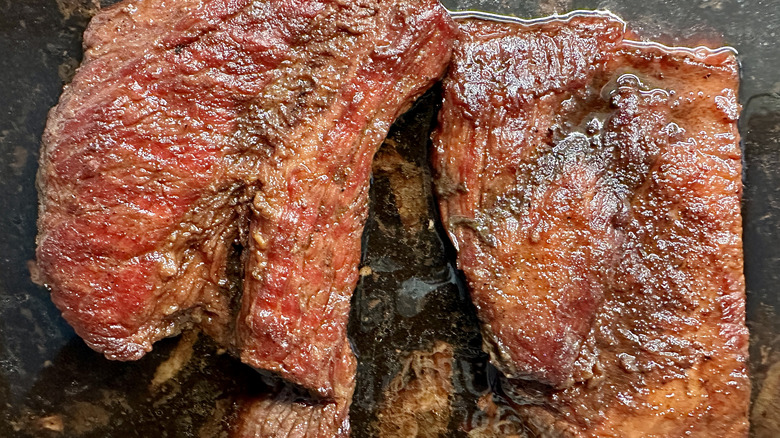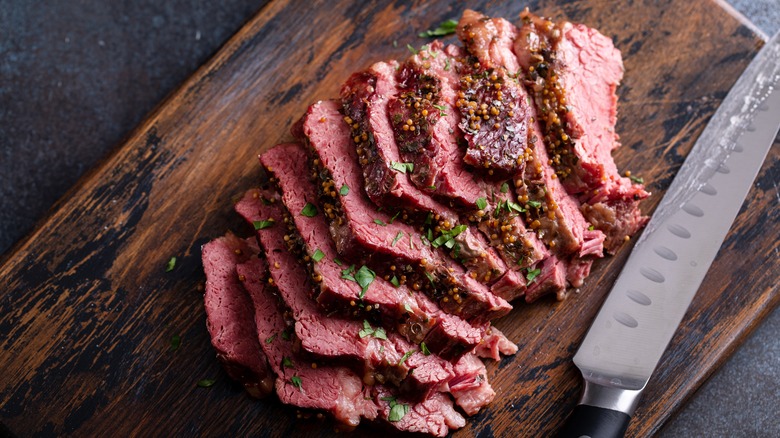10 Mistakes To Avoid When Making Corned Beef
Corned beef, like Guinness, mashed potatoes, and Irish soda bread, is a quintessential Saint Patrick's Day treat. It graces our tables every March 17th in celebration of Irish heritage, adding a hearty touch to the festive spread. Yet, for all its importance in the Saint Patrick's Day meal, mastering the preparation of this iconic delicacy can prove to be a challenging endeavor, particularly for those unacquainted with this unique cut of meat.
Rushing the cooking process, neglecting the seasoning, and slicing the meat incorrectly are just a few of the potential traps that await you if you're not careful. But thankfully, it's not all bad news. While there are plenty of ways to mess up corned beef, avoiding these potential traps isn't all that difficult. Indeed, this article will guide you through the mistakes to avoid as you prepare everyone's favorite Irish dish. By the end, you'll have a tasty, tender cut of meat your guests won't be able to resist.
1. Choosing a lean cut of meat
If you're the type of person who selects white meat over dark meat on Thanksgiving and orders dressing on the side of your salad, then the fat content of corned beef is guaranteed to scare you a bit. That's because this traditional Saint Patrick's Day dish is made using brisket, a fatty cut of meat from cows' breasts. While it's not as fat-laden as T-bone steaks or porterhouses, a single three-ounce serving of corned beef contains more than 16 grams of fat, with about one-third of that saturated (via Very Well Fit).
Given how fatty corned beef can be, the desire for a leaner cut of meat makes sense, especially if you're watching your waistline or blood pressure. But as much as we understand the urge, we strongly recommend selecting a piece with a healthy amount of marbling. Because brisket is so tough, having enough fat ensures that the meat stays tender and moist during the cooking process. Without it, you might as well gnaw on cardboard for all of the flavor and texture you'll get. Besides that, it's important to remember that a lot of the fat will render during the cooking process. And if it doesn't, you can always trim the excess fat before serving.
2. Buying a piece that's too small
Like us, you probably want to limit your corned beef consumption to Saint Patrick's Day. Sure, you might make a few Reuben sandwiches with the leftovers, but you don't want a Thanksgiving turkey situation on your hands. With all of us on board, why then is corned beef sold in such huge quantities? Depending on where you shop, you're likely to find these briney briskets sold in either two or three-pound servings.
That sounds (and looks) like an enormous quantity of meat, especially if you're only cooking for a small group. But before you rail against the Saint Patty's Day meat machine, remember that most of the volume you see in prepackaged corned beef comes from the brine used for curing. This liquid drains as the meat cooks, resulting in a cut that's up to 30% smaller than what you started with. Now that you've got a clearer idea of what you'll be working with, plan to buy about ½ to ¾ of a pound of meat for each person you'll be serving. This quantity ensures that everyone will eat their fill and that you'll have a few slices left over for sandwiches or hash.
3. Only trying prepackaged corned beef
In between buying pints of Guinness and stringing up shamrock decorations, it can be hard to find the time to shop for corned beef, let alone make your own. So, if you're up to your eyeballs in Saint Patrick's Day preparations, go ahead and buy the prepackaged kind. However, if you have an adventurous spirit and can be patient, why not try making your own corned beef this year?
Not only will you learn a new cooking technique, but you'll also get to experiment with different spice blends and create a finished product with way more flavor than commercial varieties. That's because store-bought spice packets typically contain just peppercorns, seeds (mustard, dill, and coriander), crushed red chili flakes, and bay leaves. It's not a bad start, but making your own brine allows you to add additional ingredients like juniper and allspice berries, cloves, bay leaves, cardamom, garlic, and star anise.
To be clear, not everything about making your own corned beef is rosy. For starters, you've got to measure your herbs and spices correctly. Fail to do so, and you'll end up with a wacky-tasting meal. What's more, curing meat means potentially exposing yourself to germs. Per the National Center for Home Food Preservation, Clostridium botulinum, Listeria monocytogenes, and Staphylococcus aureus can grow on incorrectly stored meat. Cooking to the right temperature — 145 F, according to the United States Department of Agriculture — is usually enough to kill them off, but if you're worried, then try our Crock-Pot corned beef recipe.
4. Not rinsing the meat before cooking
Whether you make your corned beef at home or buy it from the store, there's one thing you must do before cooking. While not included in a lot of recipes, this step is crucial to ensuring a pleasant meal. The step in question? Rinsing the meat before boiling it. Now, if you're not in the habit of making corned beef, this step might sound pretty wacky. After all, you don't rinse brisket (aka the cut of meat corned beef is made from), so why do you have to rinse corned beef? The difference lies in the curing process.
Unlike other types of meat, corned beef is cured (also known as corned) using salt and spices. In addition to tenderizing and preserving the meat, these ingredients add all kinds of flavor to an otherwise bland cut of beef. The only downside is that the salt tends to hide in the folds of the meat. If you drop the beef right into the cooking water without rinsing, you'll end up with a mouthful of salt rather than a tasty morsel. Thankfully, avoiding this salty situation is easy. Simply rinse the meat under cold running water for several minutes. Don't worry about over-rinsing or losing flavor in the process, because by this point, the salt and spices have already infused themselves into the meat.
5. Failing to fill the pot with enough water
Some people will tell you that the secret to top-notch corned beef lies in the spice blend. Others will say it's the side dishes you serve with corned beef that make the difference. Neither of these statements is wrong, however, we'd argue that cooking the meat correctly comes before everything else. Indeed, slow simmering on the stovetop is the secret to tender, melt-in-your-mouth corned beef.
When simmering, having the right amount of water in the pot is priority number one. Unless your vessel is boiling over, you usually don't have to worry about overfilling, so let's focus our attention on underfilling. Throughout the cooking process, you want to make sure there's enough water to cover the meat. To start things off on the right foot, submerge the meat in water at the beginning of the cooking process. From there, remove the lid periodically and pour in more liquid if the level is starting to dip. It's a bit of extra work, but it's essential if tender corned beef is your goal. Skip it, and you'll be left with a hunk of chewy meat only the dog will enjoy.
6. Forgetting to season the cooking water
Most prepackaged cuts of corned beef come with a small spice packet. The contents differ from brand to brand but expect to find some blend of peppercorns and spices. These are the same spices used to cure the meat and they're what help season the meat as it cooks. All you need to do is pour the packet into the cooking vessel along with the water and meat at the start of the cooking process.
If your corned beef doesn't come with a spice packet (unlikely, but possible), or you made your own corned beef at home, then there's still a way to recreate this spice blend from ingredients you've already got in the cupboard. To make it, you'll need coriander, peppercorns, mustard seeds, anise seeds, bay leaves, and crushed red pepper flakes. Feel free to add other spices such as dill seeds, fennel, cloves, and ginger, depending on your preferences. Toast the ingredients in a pan, then crush them up using a spice grinder. Besides the spices, you can also season the water by adding a can of Guinness to the pot.
7. Cooking corned beef at a high temperature
From neglecting to properly season the cooking liquid to using insufficient water, there are all kinds of ways to mishandle corned beef. Add cooking it at too high of a temperature to that list. Indeed, corned beef's tender texture emerges only after the meat simmers on low heat for several hours. That's because corned beef is made out of brisket, a cut of meat that contains lots of connective tissue. Slow cooking over low heat causes the connective tissue to gelatinize, resulting in a moist, tender final product.
If you cook corned beef over high heat, the collagen behaves in the opposite way. Instead of loosening, it becomes even tighter. The result is meat with a dry, rubbery texture. A low cooking temperature also gives the fat enough time to melt and infuse its juices into the meat, something else that'll help improve the flavor and texture. So, what's the optimal cooking temperature? There's no precise answer, but aim to keep your pot or slow cooker at a simmer instead of a boil throughout the cooking process.
8. Rushing the cooking process
Just as corned beef demands gentle heat for optimal results, so too does it require a slow, deliberate cooking process. This isn't a piece of meat you can simply toss on the stove after a long day's work and expect to savor by dinnertime. Rather, it's an (almost) full-day affair that demands meticulous planning.
Depending on the specific cut and its weight, the preparation of corned beef can span anywhere from two to five hours. If you choose to utilize a slow cooker, be prepared for an eight to 10-hour commitment. This extended cooking duration is essential due to the composition of the brisket. Brisket contains a substantial amount of collagen, a connective tissue that results in a notably tough texture in its raw state. With prolonged cooking, the collagen gradually breaks down, transforming the beef into a lusciously tender and silky delight. If you try to curtail the cooking time, you interrupt this process. The result is a chewy hunk of meat you'll need a steak knife to cut through.
9. Not allowing the meat to rest before cutting
After keeping an eye on the water level, adjusting the seasoning, and monitoring the cooking temperature, it's tempting to dig into corned beef as soon as you pull it off the stove. We're right there with you. After hours of waiting, it's almost impossible to resist stabbing your fork into the meat and breaking off a piece. As tempting as it is to sneak a cheeky bite before serving your guests, we encourage you to practice restraint.
Not only are you likely to burn your mouth, but allowing meat to rest before cutting ensures an easier cutting experience. That might sound a bit strange, so allow us to explain. When meat is hot, the juices inside are more liquid. If you cut corned beef as soon as it comes out of the hot water, you'll end up splashing these juices all over your cutting board. However, if you allow the meat to rest for several minutes, the meat relaxes and absorbs most of its juices. The result is a cleaner cutting process and a juicier slice of corned beef. Talk about a win-win scenario. In terms of how long to rest corned beef, we recommend letting it sit for 10 to 20 minutes in a warm place, like the top of the stove.
10. Slicing the meat incorrectly
When it comes to slicing corned beef, doing it the right way can make a world of difference in the final taste and texture of your dish. The key mistake to avoid is cutting the meat with the grain, which can result in a tough and chewy meal. This chewiness is the result of corned beef's composition. Brisket, the cut of meat used to make corned beef, features long muscle fibers running up and down its length. If you slice with the grain (aka in the same direction as the muscle fibers), you're essentially leaving those tough strands intact.
In order to figure out where to make your incision, flip the meat onto a side that has less fat. Next, make a shallow cut in order to determine the direction of the fibers. Once you've oriented yourself, position the meat with the fibers running diagonally away from you. From there, use a sharp carving knife to cut through the fibers. As you cut, you'll notice how easy it is to make neat, even slices you'll be proud to present to your guests.
Static Media owns and operates Tasting Table and Mashed.
